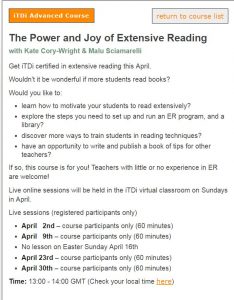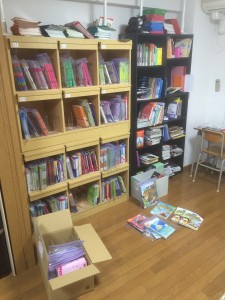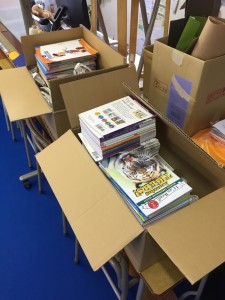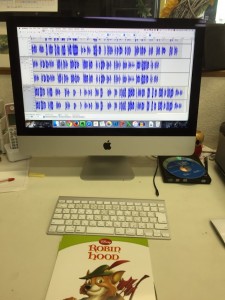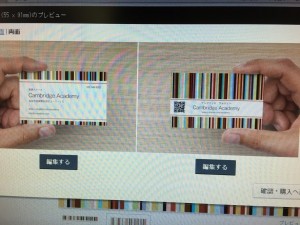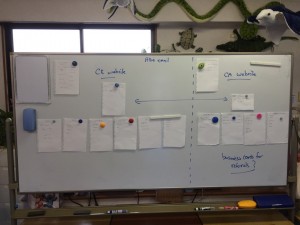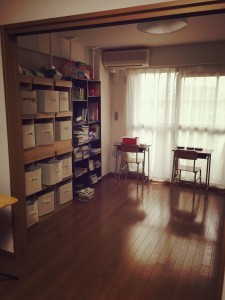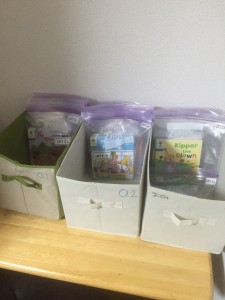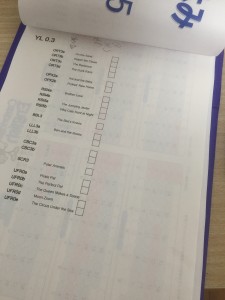iTDI: The Power and Joy of Extensive Reading
I’m taking an online course about ER through iTDI. We had the first session this evening. So far it’s a pretty good introduction to the topic.
You can see a recording of the first session here. If you like it, please consider joining the rest of the course.
Maybe see you on there!
business curriculum extensive listening extensive reading high school junior high school school management self-study
by sendaiben
11 comments
Cambridge Academy (six months in)
Extensive Reading for Secondary Students Part 2
Well, we’ve been running the Cambridge Academy for about six months now.
Academy classroom
Cambridge Academy (see previous write-up here): so far so good. We’ve run into some problems and changed course a couple of times, but the program is shaping up and it’s time for a big recruitment push. In this post I will talk about some hiccups we encountered, solutions, and future plans.
Problems so far
1. We still don’t have enough books
2. Some books don’t have commercially available audio
3. We don’t have a coherent program beyond the beginner level (over YL0.9)
4. Some students (10%>) are not performing well
5. Writing activities are not a good fit for an extensive reading class
Solutions
1. We continue to buy books and process existing ones (label and put into database and reading checklists) so that students can use them. We’ve probably doubled our existing readers since April and will probably continue doing this for the foreseeable future. Practice is making better, and our processing is getting much quicker now.
Processing new books
Processing new books involves the following steps:
- open box, remove plastic wrapping etc.
- find YL/word count information
- label books with SEG labels
- input book information into our reader database
- copy CDs and put away the masters
- put books and CDs into ziplock bag sets
- add book/set information to reading checklists
- put books on the shelves
The two major problems are if books don’t have YL/word count information, and if books don’t have CDs/audio. Right now we guesstimate YL and count words if the books are short enough. For longer books we try to find the word counts online. This site is great to find US-published series.
2. For books with no commercial audio available, we have been making our own by reading the books out loud into an iMac using Audacity to produce mp3 files that we then burn to CDs using iTunes. So far this is working very well, but it takes quite a long time and we still have over 500 books to make CDs for!
Recording audio
3. None of our students have gone beyond YL1.0 yet, but a couple of them will reach it soon. Before that happens we need to make sure we have enough books for them to read. Another problem is what to do about audio. I suspect that by the time students go over YL1.0 audio will be less important, but I am not 100% sure.
The other question is whether to continue grouping books into sets or to move to having individual books. If individual books, what will the checklists look like? I suspect all of this will get worked out over the next six months or so.
4. We have two problems with some of our students. The first is that a small number of students (two or three) seem to be exaggerating the amount they read or reading in a very perfunctory way (just looking at the pictures). I’m not sure how much of a problem this is, as they may well still be getting some benefit from the audio input. If it is a problem, I don’t really know what to do about it. I have tried talking to them, asking them about the content of books, and had them read the books out loud to me, but I am still not happy about the situation. Work in progress.
The other problem is potentially more serious. So far only one student seems to have run into it. Basically the student seems to have hit a wall around YL0.3, and is reporting that they cannot understand anything in the books at that level. I have tried talking to the student and explaining that it’s not necessary to understand everything but rather important to try and catch familiar words and think about the meaning, but I am not sure how helpful that was or how to solve this if it comes up with other students. Another work in progress.
5. Our initial model bundled extensive reading and writing practice (through weekly writing assignments) into one class, with speaking activities in the other. However, this model has several important drawbacks and we’ll be changing it in the future. Our ER classes have up to 12 students in them, so checking each student’s writing in 55 minutes is really hard and quite stressful for the teacher. Checking writing assignments in the ER class also means that our teaching assistants cannot take the class (they would be able to if it was just ER). Finally, having writing assignments in the ER class makes the class more stressful and less fun. Students are worried about finishing their writing instead of just relaxing and enjoying the reading class.
From next year we will include the writing assignments in the communication class (output), while the ER class will focus on reading and listening to the accompanying CDs.
Future plans
We have a few plans not mentioned above. The first and most important is that now that the program is getting into a half-decent shape, it’s time to try to expand it and recruit more students. So far all our students joined from within the school. Only half a dozen or so joined the school once the Academy was running, and we haven’t been actively advertising the course.
Business cards for advertising
From this week we will start actively trying to recruit new students, through our new Academy webpage and various advertising campaigns. Our goal is to have 100 students in the Academy by December 15th this year.
Planning the new website
Our website is getting a bit dated so we plan to get a new one made in November this year.
We are also going to explore whether the ER class is a standalone product. At first we went off the SEG model, which pairs an ER class with a communication class, but my friend DE suggested that the ER class might be our main product, with the communication class as an optional extra. This would be much easier to provide logistically, so I am excited to see if it is true over the next couple of months.
Another thing that we need to work on is making the ER classroom more comfortable. Right now it is set up with school-style desks and chairs, but we are planning to make more of a cafe-style with more comfortable chairs and funkier design/lighting/etc. Ideally it should be a welcoming space that students want to spend time in, and prospective students are attracted to. Work in progress, but I hope to post some pictures in the next update.
We need to find another couple of teaching assistants so we can train them before expanding the number of classes. We’re looking for 2nd-year university students at the moment.
Eventually we are hoping to open new branches in other parts of the city. I think that will be an option once we have 200 students at the original location. Another work in progress!
Any questions or advice? Please comment below.
business curriculum eikaiwa extensive listening extensive reading graded readers high school junior high school language courses school management self-study
by sendaiben
4 comments
Extensive Reading for Secondary Students
I’ve been wanting to write this post for a long time.
On April 1st this year the language school I help out at started a new section called Cambridge Academy. Getting ready for this and implementing it over the last four weeks has been a really fun challenge, and now that we are taking a little break for the Golden Week holidays I feel like I have some lessons to share.
In this post I will talk about what we are doing, why we decided to start a new sections, and a few problems and successes we have had.
Why start a new school?
Several reasons. The main one is that we weren’t happy with our existing junior and senior high school classes. It seemed that while the most able and motivated students could do very well, others did not. We gave students many chances to do work outside of class, and the ones that did got better and the ones that didn’t, didn’t. We were looking for a way to improve that.
I was also able to visit SEG in Tokyo, and see their incredible resources and program. This inspired me to start something similar in Sendai, and we have benefited hugely from using Akio Furukawa’s experiences and advice in setting up the program.
Finally, the academy format and the results we are hoping for seem to be quite commercially viable. While my main motivation with the school is to provide students with excellent education, it’s nice if the school pays for itself too.
How does the Academy work?
There are two main concepts behind the Cambridge Academy. The first is to provide students with the chance to receive large amounts of comprehensible input through graded and leveled readers, alongside speaking and writing activities. Initially the input was based mainly on books but we quickly realised the power of reading with CDs so we have since changed this to books with CDs.
The second concept is to do 55 minutes of reading/listening in the school each week. This ensures that all students will receive at least 40 hours of reading/listening per year, or 200 hours over the course of the five years we envision the ideal program lasting (JHS 1st grade to SHS 2nd grade). Of course, motivated and ambitious students will do much more at home, but with the in-class reading system ensures that all students will make some progress.
The students will also have a speaking class with a focus on production, a writing assignment each week, and the chance to do online vocabulary study with Word Engine.
What have you done so far?
At first the main stumbling block was space: we needed an extra classroom that could house the books and other resources as well as accommodate twelve students. Luckily the apartment above the school became available in March, so we quickly rented it and set it up for school use. As the Academy classes are pretty much silent, we shouldn’t have any problems with the neighbours or the landlord.
Next was gathering resources. We already had a large graded and leveled reader collection built up over the last twelve years or so, but it wasn’t enough to serve the fifty or so students who started in April, let alone the numbers we would like to see eventually. After several large orders to englishbooks.jp and Amazon, we are still playing catchup and will probably continue buying books throughout the year (this matches my experience at Tohoku University, where book resources never quite seem to meet student demand).
Main bookshelves at the Academy.
The next step was to develop a system to determine what students would do, how we would track it, and how to organise resources. Here we benefited immensely by being able to copy a lot of what SEG does. The interesting thing is that we found ourselves adopting elements of the SEG system that didn’t make sense to me at first (like having books organised in sets with CDs, and having students read while listening).
Book sets organised using ziplock freezer bags.
We had a couple of CD players when we started classes, but after I saw how much the students enjoyed listening as they read I quickly bought ten more so that we could offer a player to each student. Personal CD players can be found on Amazon.jp for between 1500 and about 5000 yen. There seem to be limited numbers as these products are no longer popular. We have also failed to find CD players that can play MP3 CDs for a reasonable price (there is a Sony model that costs about 25,000 yen, but this seems a bit too high to me). An ongoing project.
We have also noticed the need to keep track of what each student has read so that we can give them new books in a timely way. Right now the best solution appears to be a checksheet that we will put in each students file so that we have a record of that they have read. This is also a work in progress but it is going quite well.
Checksheet to track student reading.
Results so far
The first four weeks have been great. Students seem to enjoy the format and even the students who don’t seem to enjoy English classes do the reading activities willingly. About half of the students do homework, the others do not. My policy here is to encourage and support, but leave it up to each student as to how much they want to do.
For the school, the format means that we can serve up to 24 students each weekday evening (four six-student speaking classes and two twelve-student reading classes that alternate). In practice this means that three teachers can take four classes, which increases the profitability quite a bit. The schedule looks like this:
19:20-20:15
Class A speaking with Teacher 1
Class B speaking with Teacher 2
Classes C and D reading with Teacher 3
20:25-21:20
Class C speaking with Teacher 1
Class D speaking with Teacher 2
Classes A and B reading with Teacher 3
From a business perspective the profit per student in the Academy system is higher than other classes. We charge 15,000 yen a month plus tax for 44 two-hour classes a year, so I think this is a good value for students too (they would have to pay more than that each month just to buy the books they end up reading).
The specialized knowledge required to set up the system, and the cost of books and other equipment (we’ve spent over a million yen setting up the Academy, and we already had thousands of books) means that it would be difficult for other schools to copy our classes if we are successful.
Most of all, it is wonderful to see the students enjoying their studies, and achieving success each week. The Academy style classes also work very well with students who have social issues. For a teacher, it’s a very fun class to run and I hope our students will find themselves doing better at school.
What’s next?
Well, we’ll continue developing the system and trying to improve it. I suspect motivation may become a problem for some students once the novelty wears off, but I haven’t seen this so far. Hopefully the combination of success and the contrast between an hour of reading/listening and the rest of their busy day will help stave this off.
Business-wise I would like to see the Academy grow in size, and if it gets big enough I would like to move it to a new location in the city centre to increase our catchment area. Ideally this would happen in the next year or two.
So far I am very pleased with how things are going. I’ll post an update in September or so and let you know how we are doing. Please feel free to ask any questions in the comments.
Review: Oxford Junior Workbooks
An oldie but goodie
The Oxford Junior Workbook series is a great homework resource for elementary school age children. There are ten workbooks in the series, from the introductory A and B, to the 1-8 of the main series. We have been using these for many years now, and find them extremely useful as supplementary homework for children (post-phonics, pre-intermediate).
The Good
- Price. The books are 735 yen before discounts, so one of the most economical workbooks around.
- Intuitive. Most of the exercises are fairly intuitive and require little explanation. Perfect for homework.
- Well designed. The books build up language and concepts slowly in a very learner-friendly way.
- Range of activities. There are a range of activities, from colouring to matching, writing, and drawing.
The Bad
- Dated. The books are showing their age in terms of design.
- Dated. Some of the language and content is archaic (ink blot?).
- Dated. Slightly sexist and non-PC at times.
Overall
Overall the Oxford Junior Workbook series is a great way to provide extra work outside of class that student enjoy and find useful. They can be used in lockstep by assigning specific pages as homework, or individually by allowing students to work at their own pace. The books are cheap enough that buying one or two each year shouldn’t break the bank.
Very much recommended.
extensive reading Language learning presentations self-study university
by sendaiben
6 comments
Video: Extensive Reading Workshop for University Staff (Japanese)
ER for Staff -a training workshop at Tohoku University
This 90-minute workshop on using extensive reading for self-study in English was conducted in Japanese at the Tohoku University Library on December 26th, 2013. I really don’t like listening to myself speak Japanese (it sounds very different to what I hear in my head) but I guess this is something I will get used to eventually (after all, I went through the same process watching my presentations in English and am now fairly comfortable with that).
